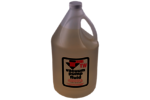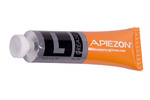- ▶
- Heaters/Source
- ▶
- Agilent Heaters and SensorsMass Spectrometry, Scientific Supplies & ManufacturingScientific Instrument Services 5973 Source Heater Tamper Resistant Allen Wrench 5973/5975 Quad Sensor 5985 Source Heater Assembly Agilent Interface Heater Assembly 5971 Interface Heater

- ▶
- VacuumPumps Oils/Greases Gauge & Tubes Hose & Accessories Filters - Oil/Charcoal Foreline Traps Gaskets & Material Fittings O-Rings Pump Parts (Precision Plus) Quality Monitor System Distillation Control Acoustic Enclosures For Rotary Vane Pumps Other Vacuum Accessories Digital Vacuum pressure regulator (VPC) Catalog Page F1
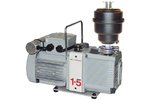
- ▶
- Oils/Greases
- ▶
- Apiezon Oil/Grease/Wax
- ▶
- Apiezon Waxes (This Page)
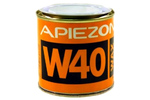 Apiezon® W40 Wax Wax W40 is relatively soft; softening at about 40'C.
Apiezon® W40 Wax Wax W40 is relatively soft; softening at about 40'C.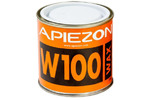 Apiezon® W100 Wax This wax is softer than Wax W and softens between 50 degrees to 60 degrees C.
Apiezon® W100 Wax This wax is softer than Wax W and softens between 50 degrees to 60 degrees C. Apiezon® W Wax The highest melting of three waxes, Apiezon Wax W softens between 80 degrees to 90 degrees C and is particularly suitable for sealing joints which may become warm in operation.
Apiezon® W Wax The highest melting of three waxes, Apiezon Wax W softens between 80 degrees to 90 degrees C and is particularly suitable for sealing joints which may become warm in operation.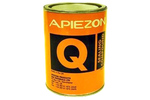 Apiezon® Compound Q Wax Sealing Compound Q is a putty-like substance.
Apiezon® Compound Q Wax Sealing Compound Q is a putty-like substance.
High vacuum joints of a more permanent nature, not required to be movable, are best sealed with one of the Apiezon® waxes rather than by a grease. Three grades of wax are available, all basically similar, but differing in their hardness and softening points, from hard Wax W softening at 80' to 90'C to relatively soft Wax W40 softening at about 40'C. Wax W would be chosen for sealing most joints; a softer grade is used where the lower softening point makes application easier or where the softer wax is desirable because of probable vibration of the joint.
Apiezon® waxes have powerful gettering' properties similar to the greases. This coupled with their purity and very'clean'meltdown characteristics has led to their extensive use in the electronics industry. Apiezon waxes are used in the manufacture of silicon transistors and integrated circuits, both as miniature mounting blocks (in the form of small chips) and by deposition from a solution in a suitable solvent, as the masking medium in etching processes. Their extreme chemical inertness makes them very resistant to etching fluids such as hydrofluoric acid, nitric acid, acetic acid, but they are easily and rapidly removed by hydrocarbon or chlorinated solvents.
Spec Tables
| Apiezon® Waxes Technical Data | Wax W40 | Wax W100 | Wax W | Compound Q |
|---|---|---|---|---|
| Approximate softening point, degrees C | 45 | 55 | 85 | 45 |
| Temperature for application, degrees C | 90 | 110 | 130 | Ambient |
| Maximum temperature for use, degrees C | 40 | 50 | 80 | 30 |
| Specific gravity at 20 deg.C/15.5 deg.C | 1.017 | 1.567 | 1.055 | |
| Specific gravity at 30 deg.C/15.5 deg.C | 1.010 | 1.561 | 1.048 | |
| Average molecular weight | 1140 | 1160 | 1214 | |
| Coefficient of expansion per deg.C over 20 deg.C-20 degC | 0.00063 | - | 0.00062 | |
| Thermal conductivity Btu. in/ft2h degrees F | 1.23 | 1.18 | 1.31 | |
| w/m degrees C | 0.177 | 0.170 | 0.189 | |
| Specific heat at 25 degrees C, cal/g | 0.51 | 0.70 | 0.43 | |
| Joule/g | 2.1 | 2.9 | 1.8 | |
| Loss tanget | 0.015 | 0.016 | 0.015 | |
| Permittivity | 2.9 | 2.7 | 2.8 | |
| Volume resistivity, ohm/cms | 5.055x1015 | 1.64x1015 | 6.31x1015 |
Extra Info
Their 'gettering' action ensures that the surface is left chemically clean. The waxes have also been used as protective coatings for printed circuits ensuring complete protection of the copper circuit from acid etching processes and from air oxidation, but allowing direct soldering straight through the wax which forms an excellent flux.
Apiezon waxes, like the greases, have outstandingly good electrical insulating characteristics with high breakdown voltages. They offer interesting possibilities for use as encapsulating or impregnating materials in electrical equipment. The electrical properties of the Apiezon waxes are shown in Table 4.
* Over temperature range 20 to 30o C
Removal of Greases / Waxes
Apiezon Greases and Waxes can be removed by the following hydrocarbon solvents:
* Mineral Spirits * Trichloroethylene * Kerosene * Toluene * Xylene
Types
Apiezon Wax W100This wax is softer than Wax W and softens between 50 degrees to 60 degrees C. It is used where a wax seal is needed, but where the softer wax will reduce the danger of a joint cracking if the parts are subject to vibration. The safe working temperature for Wax W100 is obviously lower than for Wax W and is about 50 degrees C. Estimated vapor pressure is 6 x 10-9 torr at 20 degrees C.
Apiezon Wax W
The highest melting of three waxes, Apiezon Wax W softens between 80 degrees to 90 degrees C and is particularly suitable for sealing joints which may become warm in operation. Wax W should be heated to about 100 degrees C for ease of application. Estimated vapor pressure is 6 x 10-9 at 20 degrees C.
Sealing Compound Q
Sealing Compound Q is a putty-like substance. It is a relatively low cost, extremely versatile sealing medium used for a great many purposes in vacuum work where not too low a vapor pressure is required (vapor pressure at 20 degrees C is approximately 1 x 10-4 torr). Thus Compound Q is used to seal joints and fill holes and gaps on the rotary pump side of the system. It is suitable for sealing around the edges of flat unground joints as in testing operations where it is necessary to blank off a part of the apparatus temporarily. A further example of its use is in sealing glass cylinders to metal plates, as is often done to produce temporary vacuum enclosures. Sealing Compound Q is sufficiently firm at room temperature to remain in position, yet is sufficiently soft to allow ease of molding by hand and can be readily removed when required.
Precautions
PRECAUTIONS: Apiezon Products - Health and Safety
Apiezon products have been widely and safely used in vacuum distillation apparatus in both industry and laboratories for a number of years. As a result they should not present a health hazard assuming normal standards of industrial hygiene and safety are followed in their handling.
All Apiezon products are bases on petroleum products of a low order of acute toxicity. However, certain individual develop a rash after repeated contact. Therefore, it is recommended that gloves be worn to handle Apiezon. If Apiezon material is inadvertently in contact with the skin, wipe the area carefully, then cleanse thoroughly using a mild soap. Should any Apiezon products be heated for application, vent the fumes and avoid breathing the warm vapors.
In terms of explosion and fire, Apiezon products are considered non-hazardous.


